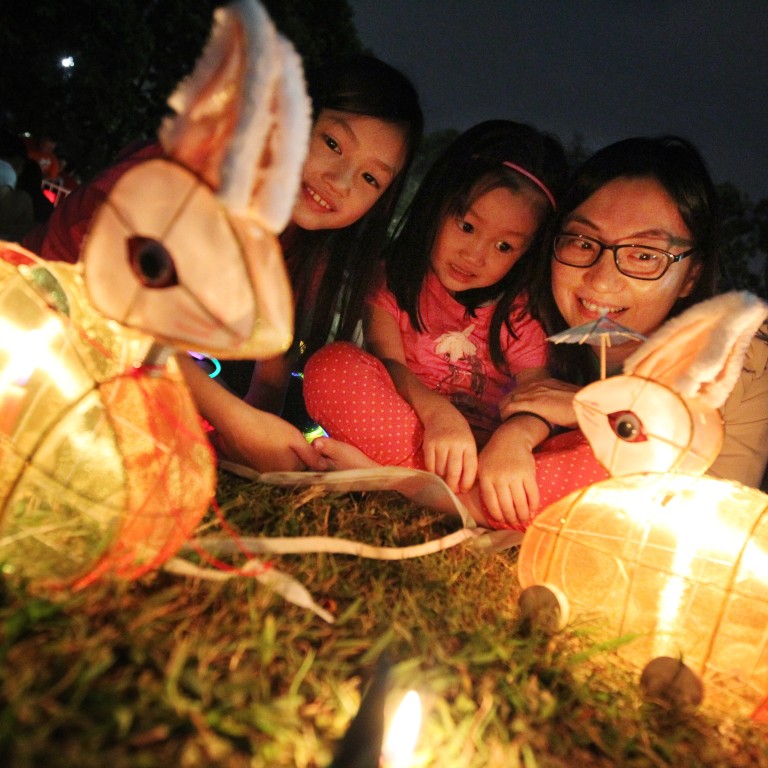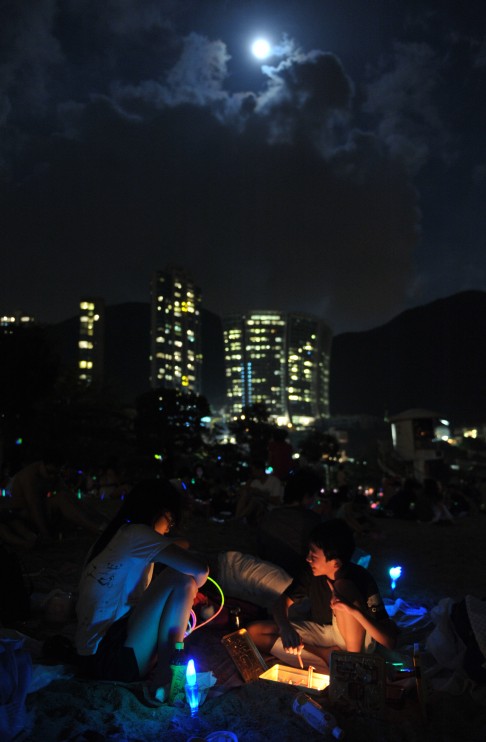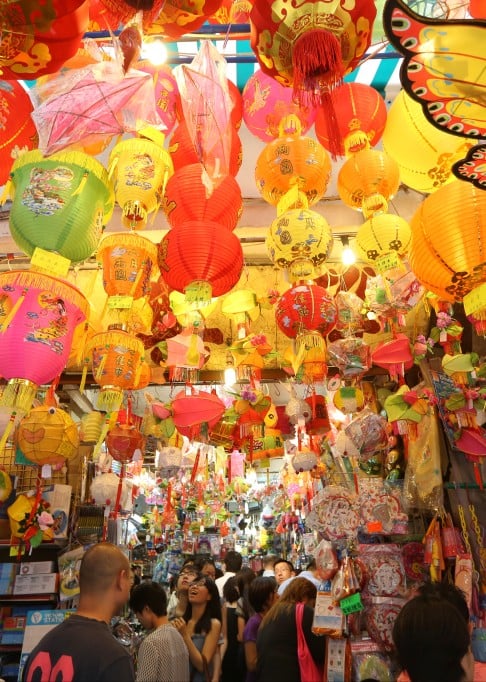
Everything Hongkongers need to know about Mid-Autumn Festival
From supermoons to lantern trends and the messages in mooncakes, all the facts about the second most important traditional Chinese holiday after Lunar New Year
Many cultures have historically associated the full moon with a time of abundance. When our satellite is at its fullest, tides rise higher. In the autumn, when it appears closest to the earth, it’s time for the harvest and thanksgiving.
These days, there’s no need for a lunar clock or an alarm clock. The moon festival is a night to spend with friends and family, knowing you don’t have to get up for work in the morning. In Hong Kong, the festival is also an alternative Valentine’s Day, when couples spend a romantic evening together under the moonlight.
The 15th day of the eighth lunar month, Mid-Autumn Festival is the second most important Chinese holiday after Lunar New Year.
Families and friends typically get together for dinner, partly to fuel up for a long night. Popular activities include climbing hills to be closer to the moon, or moon-gazing at beaches or in parks with candles and lanterns.

Victoria Park in Causeway Bay is a large gathering spot for moonbathers, and in recent years the government has tried to stamp out one custom there that’s particularly popular among young children – “wax-boiling”, or playing with lit candles. It’s a messy game that can also result in serious burns requiring hospital treatment.

The moon festival is celebrated across parts of East Asia, including greater China, although customs vary. In Hunan province, young women from the Dong minority take vegetables from a neighbour’s garden – preferably the target of their affections – and offer a cup of tea in return. It’s believed that at this time, moon fairies sprinkle nectar on the earth to encourage selflessness. The custom is called “stealing moon dishes”.
Ancient origins
The tradition of Mid-Autumn Festival has roots dating back thousands of years, and its origins are largely a mystery. In China, emperors have made offerings to the autumn moon as far back as the Shang dynasty (1600BC-1046 BC), historians believe. The practice later became common among high officials and rich families.
Beijing’s Temple of the Moon dates to the Ming dynasty (1368-1644), and emperors continued to make offerings to the mid-autumn moon throughout the Qing dynasty (1644-1912).
Records show it became common for farmers to make offerings to the autumn moon during the Three Kingdoms period (220-280), and it became a recognised festival during the Tang dynasty (618-907).

Trip to the moon
It’s no coincidence that China’s lunar exploration programme is called Chang’e. It’s also the name of the moon goddess, who brings good luck to those who remember her. There are numerous versions of the tale of Chang’e, all involving her husband, Hou Yi.
In one tale, archer Hou Yi shot nine of the 10 suns out of the sky to cool the earth. Wangmu, the queen of heaven, rewarded him with an immortality potion, which he gave to Chang’e for safekeeping. This was noticed by the scoundrel Peng Meng, who tried to steal it. So Chang’e hurriedly drank the elixir and flew to the moon.
In an alternative version, Chang’e and Hou Yi were immortals banished to earth by the king of heaven, the Jade Emperor, when Hou Yi shot nine of the 10 suns of the sky but spared one. The suns were the emperor’s sons.
In yet another story, Hou Yi is a foul-tempered emperor, and Chang’e takes the immortality potion to spite him.

The Jade Rabbit
Some see a man on the moon’s pitted surface, but it’s also possible to make out a rabbit – which lives there with Chang’e. When China’s Chang’e-3 space mission delivered the Jade Rabbit lunar rover to the moon in 2013, it was a legend revisited.
According to one version of the myth, the Jade Emperor came down from heaven in disguise in search of a helper to mix potions. He became hungry and encountered a monkey, a fox and a rabbit. The monkey and fox offered the old man food, but the rabbit had none. So he threw himself into a fire and offered his body for food. For this, the rabbit was made immortal and went to live on the moon, where he can still be seen bent over his pestle and mortar, mixing herbs.

Stunning supermoon
Autumn’s full moon appears to be bigger at this time of year because it is closer to earth than at other times. The relative distance changes over the course of the year due to the satellite’s eliptical orbit around the earth. This path takes a narrower angle during autumn, bringing it closer to us.
The illusion of a bigger full moon is enhanced when it is just above the horizon, and can take on an orange tinge – like the egg yolk in a mooncake. This colouring effect stems from the fact that the moonlight must pass through more of the atmosphere on the horizon, where bluer photons are scattered. If the moon appears orange or red when it is directly overhead, it’s because of dust or another source of pollution.

Let there be lights
It’s not known how long lanterns have been linked to the moon festival, but consider this: a plain, globe-shaped lantern with a candle inside illuminating the surface resembles the moon. As the festival nears, all districts in Hong Kong erect elaborate, colourfully illuminated displays of stick-framed lanterns. The themes limited only by the imagination.

For children, meanwhile, a hand-held lantern is a must, and they come in all shapes and sizes. Although stick-framed lanterns in the shape of rabbits, fish and stars are still sold, times have changed. Today they are more likely to be battery powered and plastic. Contemporary cultural icons that have come and gone as lantern trends include Ultraman, Pikachu, Hello Kitty and Buzz Lightyear. This year it’s the turn of the Minions.
Sky lanterns – which fly skywards powered by candles – were also once popular. The practice is forbidden in Hong Kong because they pose a fire risk.

Munching mooncakes
History tells us that mooncakes were once stuffed with more than just egg yolks and bean paste. One mid-autumn during the Yuan dynasty (1271-1368), revolutionaries used them to pass secret messages to one another. The rebellion was a success, and its leader, Zhu Yuanzhang, went on to establish the Ming dynasty. They were thereafter eaten during the autumn full moon to commemorate the rebellion.
However, mooncakes were around much earlier than that. Historians say the first mention of the pastries is from the Tang dynasty, but evidence suggests they are even older. Like the moon itself, they represent unity and completeness.
The filling in mooncakes varies throughout China, though they commonly include ingredients such as egg yolk, lotus seed, sesame seed, red bean and dates. The calorie-heavy cakes are not to everyone’s liking. A survey by environmental group Green Power found that 68 per cent of families give them to friends, but 69 per cent said they didn’t like receiving them.

Producers are increasingly adapting to modern tastes, and now make mooncakes out of everything from chocolate to ice cream.
What else
Although the festival was suppressed by the Communist Party for decades, it was listed as part of China’s intangible cultural heritage in 2006. Two years later, it became a public holiday on the mainland.
This year’s autumn moon coincides with a lunar eclipse, but it won’t be visible in Hong Kong.
Unfortunately, due to atmospheric conditions, it often rains or is cloudy on the night of a full moon.

